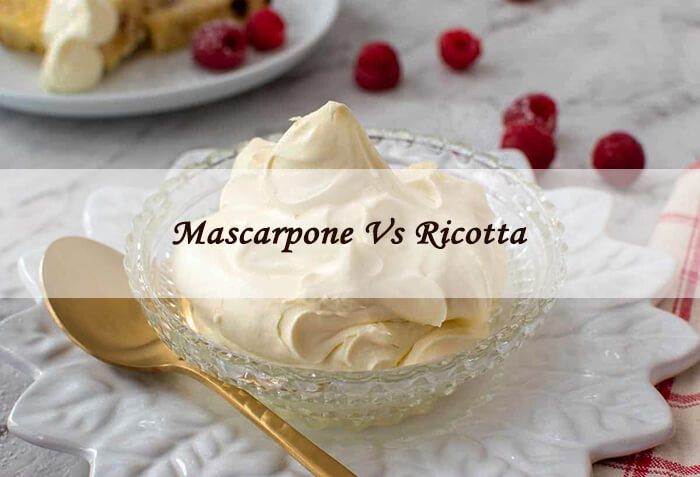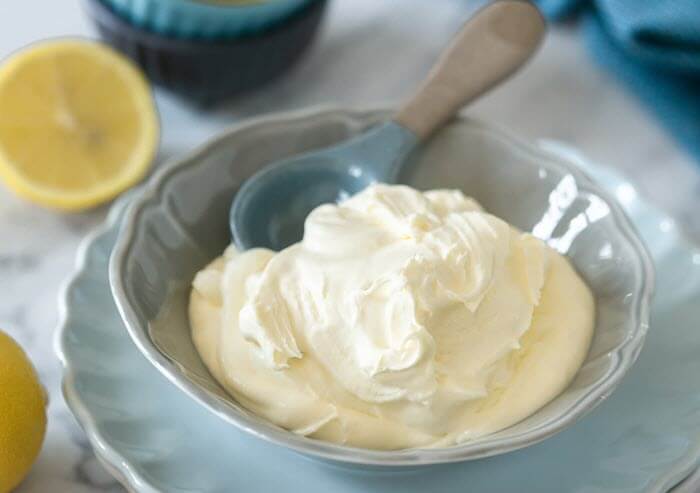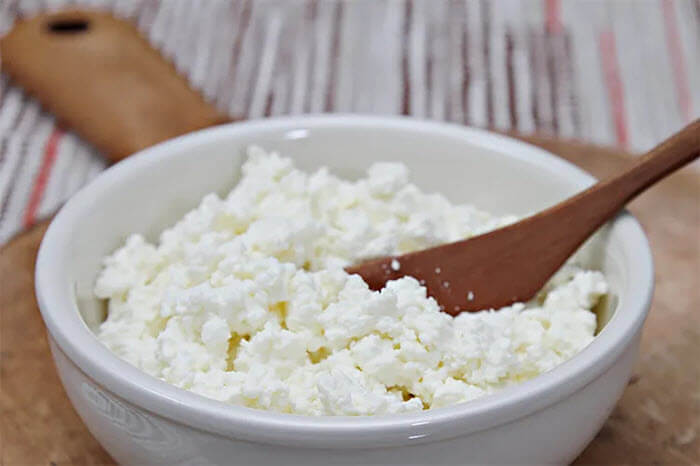Most Italian cuisines are made with ricotta and mascarpone, particularly in desserts.
So what do you do if a recipe calls for one ingredient but you only have the other one? Of course, you look up their differences!
5-Second Summary
The texture and flavor are what really make a difference.
Ricotta cheese has a gritty texture, whereas mascarpone is silky. Mascarpone cheese has a sweeter, nuttier flavor than ricotta cheese, which has a sweet flavor.
In this article, let’s explore the differences between mascarpone and ricotta.
Table Of Contents
What is Mascarpone?
Mascarpone is also referred to as Italian cream cheese.
In the past, fresh cow milk and herbs were used to make it, but today you can make it with just two ingredients: heavy cream and citric acid.
Mascarpone, which has a smooth and spreadable texture, is a triple cream cheese. It tastes sweet and nutty.
Mascarpone has a fat level of 60–70%, which indicates that it is high in butterfat. As a result, it’s a crucial ingredient in sweets like Tiramisu, Italian coffee, and chocolate.
Mascarpone cheese can be added to both sweet and savory meals to improve flavor without overpowering the original flavor. It tastes good with coffee or cocoa as well.
It can also be served as a dessert on its own with any kind of syrup!
What is Ricotta?
Another soft Italian cheese prepared from the milk of sheep, cows, goats, or buffalo is called ricotta.
Importantly, the milk left over after making other whey cheeses was used to make this cheese.
Many Italian pastries, like cannoli, cheesecake, and similar items, frequently use ricotta. Ricotta can also be used as a filling cheese for pasta dishes like cannelloni and ravioli.
Ricotta has a creamy, mild flavor and a smooth, thick consistency. Since it contains little salt, it is frequently used in desserts.
To make ricotta firm and suited for grating, it is occasionally oven-dried or air-cured.
Further reading: 5 Best Ricotta Cheese Review
Differences Between Ricotta And Mascarpone
The two cheeses have several distinctions in terms of flavor, texture, and appearance.
Differences | Mascarpone | Ricotta |
Texture | Silky, rich | Gritty |
Flavor | Sweeter, more acidic | Less acidity |
Origin | Lombardy, Italy | Italy |
Moisture | Dense | Wobblier |
Appearance | Ivory tint | Creamy white |
Uses | Desserts | Savory recipes |
Calories | 2 – 3 times more calories | Less calories |
Texture
Ricotta
Ricotta is gritty due to the way it is prepared, so keep that in mind if the texture is crucial for the dish you’re preparing.
Remember that American ricotta is smoother but still has a gritty texture.
Mascarpone
On the other hand, mascarpone is a silky, rich cheese that works well as a cream basis.
Editor’s Comment
Depending on what you’re making, you can utilize either. Both mascarpone and ricotta work well as fillings.
Because mascarpone contains a lot of milk fat, keep in mind that it could split during baking.
Flavor
Mascarpone
Mascarpone is used largely in desserts since it is sweeter than ricotta. Additionally, as it is more acidic, it is better suited for many desserts.
Ricotta
In comparison to mascarpone cheese, ricotta has less acidity and a slight hint of sweetness.
Ricotta can occasionally be aged and allowed to dry, which gives it a stronger flavor and more salinity.
Origin
Mascarpone
The region of Lombardy in northern Italy is where mascarpone cheese first appeared. Fresh curd, often known as mascarpone, was a specialty of local dairymen.
Ricotta
Ricotta is also another Italian product and its roots can be found in the rural wilderness, where travelers prepare their meals in sizable kettles over open flames.
Ricotta gets its name from the fact that you have to boil twice.
Moisture
Ricotta
Ricotta is a wobblier, more liquid cheese. As a result, it will spread more readily than mascarpone, but if your dessert has to stay dry, it may potentially spoil it.
Or, you can take advantage of this. For example, ricotta can be used to make desserts where the layers need to soften since it seeps into the layers of the cake.
Mascarpone
Mascarpone, on the other hand, is preferable for dressing a cake since it will stay in place.
It is a very dense cream that will clump together if you need it to because it has low moisture content and high-fat content.
Appearance
Mascarpone
Mascarpone cheese is primarily white; however, it has an ivory tint.
It doesn’t appear like cheese for the first 10 to 12 hours after it’s been cooked. Mascarpone cheese can become yellow if it gets old.
Ricotta
On the other hand, ricotta seems creamy white. Faint pink, green, or blue spots can occasionally appear on ricotta cheese.
It indicates that the cheese has become stale and should be avoided.
Uses
Mascarpone
Mascarpone is a famous ingredient in many desserts because of its pleasantly creamy and silky texture with a sweet flavor profile.
The best uses for mascarpone’s properties are in desserts like cheesecake and tiramisu.
Ricotta
In comparison, ricotta is considerably more suited to savory recipes. If you grate ricotta over pizza or lasagna, the dish will be incredibly creamy and light.
Additionally, spreading ricotta onto a dish is simpler. Ricotta is easy to grate on top of dishes because of its granular texture.
Editor’s Comment
This does not imply that ricotta or mascarpone cannot be used in savory dishes or that they cannot be used in desserts.
It’s just that people are more familiar with using mascarpone in desserts. The same holds true with ricotta.
Calories
Choosing the best cheese involves more than just personal preference. You should also think about how it will affect your diet.
Ricotta cheese has about 20 grams of fat per cup, but mascarpone can have up to 115 grams of fat per cup. Additionally, ricotta has a different nutritional profile than mascarpone.
Ricotta cheese typically has a fat concentration of 10 to 15%, whereas mascarpone can have fat content as high as 55% per cup.
As a result, mascarpone can have 2 – 3 times more calories per serving than ricotta cheese, depending on its unique source.
If you want to limit the number of calories you consume each day, you should absolutely take this into account.
The amount of protein in the diets of the two cheeses also stands out as being different. Whey, which is mostly leftover milk protein, is used to make ricotta. Ricotta has 28 grams of protein per cup.
Mascarpone, on the other hand, comprises 10 – 11 grams of protein per cup, which is significantly less than ricotta.
FAQs About Mascarpone and Ricotta
Can I use mascarpone instead of ricotta in lasagna?
Yes, ricotta can be replaced with mascarpone. You can use ricotta with lasagna, pizza, and other dishes because many people like the texture of ricotta.
Which is healthier, mascarpone or ricotta?
With around half the calories and fat of mascarpone, ricotta, which is made from milk and whey, is a far healthier substitute to use in cooking and baking.
Which is sweeter, mascarpone or ricotta?
Mascarpone is used largely in desserts since it is sweeter than ricotta. Additionally, because it is more acidic, it is better suited for many of the desserts in which it is used.
In comparison to mascarpone cheese, ricotta has less acidity and a slight hint of sweetness.
Conclusion
Ricotta and mascarpone do certain things differently, but this does not imply that one is superior to the other.
It simply means that to know which ingredients to use, you must know what you intend to cook or bake.
Mascarpone should be used when you want a smooth, creamy texture. Ricotta should be used when you want a flavor that is fresher and lighter.



